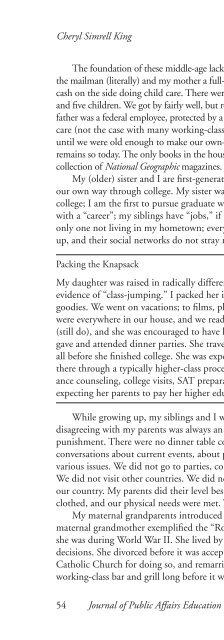WINTER 2012 - National Association of Schools of Public Affairs and ...
WINTER 2012 - National Association of Schools of Public Affairs and ...
WINTER 2012 - National Association of Schools of Public Affairs and ...
Create successful ePaper yourself
Turn your PDF publications into a flip-book with our unique Google optimized e-Paper software.
Amy E. Smith <strong>and</strong> Ignacio J. Martinez-Moyano<br />
A variety <strong>of</strong> strategies have been proposed to address these issues. In<br />
general, these strategies can be grouped into three primary categories: teaching<br />
techniques, course content revision, <strong>and</strong> pre-course training. These categories are<br />
described next.<br />
Teaching Techniques<br />
Many have proposed specific teaching techniques or tools to address<br />
challenges inherent in teaching statistics. For example, experiential learning<br />
has been suggested as a technique for building student beliefs that statistics is<br />
valuable, reducing test anxiety for students, <strong>and</strong> integrating statistics into the<br />
lives <strong>of</strong> students—thus increasing its perceived value (Cobb, 1991; Snee, 1993;<br />
Zanakis & Valenzi, 1997). Experiential learning in statistics involves working<br />
with real data, solving real problems, <strong>and</strong> improving real processes (Calderwood,<br />
2002; Snee, 1993). 2 Strasser <strong>and</strong> Ozgur (1995) suggest the use <strong>of</strong> case studies, a<br />
technique similar to experiential learning.<br />
In teaching statistics to social <strong>and</strong> behavioral science students, humor is<br />
favored by instructors as a tool for overcoming math anxiety. Schacht <strong>and</strong><br />
Aspelmeier (2005) <strong>and</strong> Forte (1995) use cartoons to reduce student anxiety<br />
about math <strong>and</strong> statistics. These authors contend that students suffering from<br />
math anxiety tend to keep these feelings secret <strong>and</strong> thus avoid seeking help from<br />
the instructor or classmates. This can lead to student failure as well as instructor<br />
perception that students are lazy or unprepared. Humor <strong>and</strong> laughter can be<br />
used to acknowledge feelings <strong>of</strong> math anxiety in students <strong>and</strong> reduce tension.<br />
Others have suggested applying statistics to current events by using<br />
newspaper articles <strong>and</strong> other news sources as a way to persuade students that<br />
statistics may be valuable in their careers <strong>and</strong> lives (Peiris, 2002; Strasser &<br />
Ozgur, 1995; Zanakis & Valenzi, 1997; Calderwood, 2002). For example, if the<br />
government claims in a newspaper article that the unemployment rate is 7% <strong>and</strong><br />
an opposing group claims otherwise, showing students how this dispute can be<br />
resolved by using statistics will help persuade them that statistics does, in fact,<br />
have real-life value (Peiris, 2002).<br />
For others, making statistics memorable, exciting, <strong>and</strong> more fun are also<br />
ways to increase student interest in, <strong>and</strong> perceived value <strong>of</strong>, the subject (Sowey,<br />
1995; Strasser & Ozgur, 1995). Instructor excitement about course materials will<br />
affect students in positive ways. When an instructor is passionate about course<br />
material, it is easy for students to become excited as well.<br />
Students have many different thinking <strong>and</strong> learning styles. Kolb <strong>and</strong> Kolb<br />
(2005) assert that the way individuals learn, which is influenced by such factors<br />
as personality type, education specialization, career choice, <strong>and</strong> current job<br />
role <strong>and</strong> tasks, shapes the course <strong>of</strong> their personal development <strong>and</strong> learning<br />
styles. Snee (1993) suggests incorporating a variety <strong>of</strong> learning methods into<br />
the statistics curriculum to accommodate a range <strong>of</strong> learning styles. While<br />
some students learn best by reading books <strong>and</strong> listening to lectures, others learn<br />
112 Journal <strong>of</strong> <strong>Public</strong> <strong>Affairs</strong> Education

















